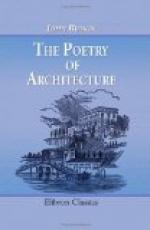[Footnote 3: The annexed illustration will, perhaps, make the remarks advanced more intelligible. The building, which is close to the city of Aosta, unites in itself all the peculiarities for which the Italian cottage is remarkable: the dark arcade, the sculptured capital, the vine-covered gallery, the flat and confused roof; and clearly exhibits the points to which we wish particularly to direct attention; namely, brightness of effect, simplicity of form, and elevation of character. Let it not be supposed, however, that such a combination of attributes is rare; on the contrary, it is common to the greater part of the cottages of Italy. This building has not been selected as a rare example, but it is given as a good one. [These remarks refer to a cut in the magazine text, represented in the illustrated edition by a photogravure from the original sketch.]]
32. Having now reviewed the distinctive parts of the Italian cottage in detail, we shall proceed to direct our attention to points of general character. I. Simplicity of form. The roof, being flat, allows of no projecting garret windows, no fantastic gable ends: the walls themselves are equally flat; no bow-windows or sculptured oriels, such as we meet with perpetually in Germany, France, or the Netherlands, vary their white fronts. Now, this simplicity is, perhaps, the principal attribute by which the Italian cottage attains the elevation of character we desired and expected. All that is fantastic in form, or frivolous in detail, annihilates the aristocratic air of a building: it at once destroys its sublimity and size, besides awakening, as is almost always the case, associations of a mean and low character. The moment we see a gable roof, we think of cock-lofts; the instant we observe a projecting window, of attics and tent-bedsteads. Now, the Italian cottage assumes, with the simplicity, l’air noble of buildings of a higher order; and, though it avoids all ridiculous miniature mimicry of the palace, it discards the humbler attributes of the cottage. The ornament it assumes is dignified; no grinning faces, or unmeaning notched planks, but well-proportioned arches, or tastefully sculptured columns. While there is nothing about it unsuited to the humility of its inhabitant, there is a general dignity in its air, which harmonizes beautifully with the nobility of the neighboring edifices, or the glory of the surrounding scenery.
33. II. Brightness of effect. There are no weather stains on the walls: there is no dampness in air or earth, by which they could be induced; the heat of the sun scorches away all lichens, and mosses and moldy vegetation. No thatch or stone crop on the roof unites the building with surrounding vegetation; all is clear, and warm, and sharp on the eye; the more distant the building, the more generally bright it becomes, till the distant village sparkles out of the orange copse, or the cypress grove, with so much distinctness as might be thought in some degree




